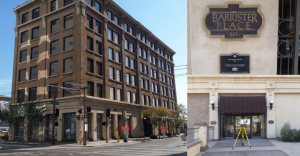Preserving history with laser scanning
 Laser scanning technology might sound like something out of a science fiction film, but it’s a real-world tool that provides a non-intrusive means of gathering vast amounts of data about specific buildings and structures. With laser scanning technology, we can literally see through buildings, providing our clients with valuable visual insights.
Laser scanning technology might sound like something out of a science fiction film, but it’s a real-world tool that provides a non-intrusive means of gathering vast amounts of data about specific buildings and structures. With laser scanning technology, we can literally see through buildings, providing our clients with valuable visual insights.
In addition, laser scanning allows us to model virtual walkthroughs, interference detection, containment analysis and interactive 3D models, but it’s the technologies’ ability to literally understand foundational and structural challenges that make it a valuable tool in protecting historic buildings for years to come.
How do you X-ray a building? With laser scanning, of course
If you feel sick for longer than a few days, you visit a doctor, right? At your appointment, the nurse will take your temperature, and your blood pressure, they’ll ask you a series of questions and then look in your ears, eyes, nose and throat. Eventually, the doctor sees you, and if necessary, orders further tests including X-rays, PET scans, etc.
As structures like bridges and buildings get older, their integrity comes into question. Unfortunately, you can’t take a building to the doctor and have it examined, but with laser scanning technology, we can provide the next best thing: a clear picture of what’s going on within a buildings’ inner-workings. From piping and wiring to roofing and wall integrity, laser scanning can provide a clear and comprehensive picture of everything that’s going on.
Historic buildings that we have helped preserve
The laser scanning and survey team here at McNeil Engineering have had the pleasure of working to preserve a number of historic structures both here in Utah and around the world, including:
- Masonic Temple – Salt Lake City, UT
- Garfield School – Salt Lake City, UT
- Casino Star Theater – Gunnison, UT
- Capitol Theater – Salt Lake City, UT
- Mumbai Mosques – India
Laser scanning case study: The Psycho Hotel in Phoenix, AZ
One of our most recent historical preservation projects involved the historical Barrister Place building in downtown Phoenix. This incredible building has a storied past and opened in 1915 as the Jefferson Hotel. At the time of its opening, The Jefferson Hotel was the tallest building in the state of Arizona, and became so famous that Alfred Hitchcock used it in the beginning of his classic horror movie “Psycho.”
We used 3D scanning to scan the exterior of the structure for our engineering partner in Phoenix, Hubbard Engineering who was retained by the City of Phoenix Economic Development Agency. Our use of 3D scanning created a highly accurate representation of existing conditions of the building for historical documentation prior to renovation work and future expansion.
Ultimately, our partners were able to use the information that we provided to make sound construction and safety decisions, a process that saved time and increased efficiency.
We’re here to help you
The 3D Laser Scan team at McNeil Engineering relies on our technical experience and specialized expertise to create personalized solutions for our clients. We use high definition laser scanners, total stations, as well as modeling and point cloud software to provide comprehensive, record surveys, 3D CAD models and detailed 2D isometric drawings.
Whether you’re the owner of a historic commercial building or operate your business out of an aging structure, laser scanning technology can provide you with necessary insights and information to improve safety, boost energy efficiency, and keep your building in tip-top shape for years to come. There’s no need to worry about damage or prep-time either. Our technicians are extremely skilled and can complete all scanning in a non-intrusive manner within just a few hours.

